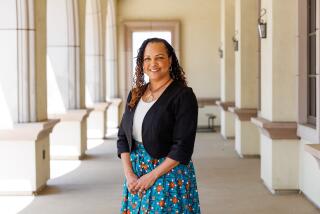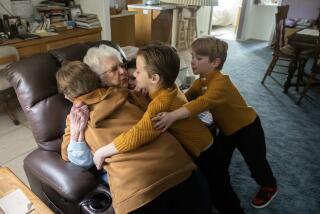School Helps People With Down Syndrome Blaze Own Trails
- Share via
EDMESTON, N.Y. — With his baseball cap stylishly swung around backward, 19-year-old Casey Bryant vigorously flattens the mound of dough with his roller as he announces his plans for the future.
“I want to work in a pizza parlor,” he says.
A rather ordinary dream for most. But for Bryant and the other 83 residents at Pathfinder Village, the country’s only lifelong residential community for people with Down syndrome, achieving the ordinary often amounts to the miraculous.
In a few minutes Bryant will grab his backpack and hurry off to class. His internship at the bakery is teaching him skills that will suit him well when he graduates.
“I like pizza,” he says. “I know I can’t eat it all. I like to make it anyway.”
“He takes a lot of pride in what he does, so he always tries to do it well,” says Joy Miller, the bakery’s manager and Bryant’s boss. “Really, he’s just like any normal 19-year-old: sports, music, dancing with the girls.”
Normalcy. It is one of the keystones of Pathfinder Village, now in its 21st year. The others are independence, self-esteem and confidence.
“Down syndrome isn’t the end of the world. It’s the beginning of a precious life,” says Marian Mullet, a nurse whose vision has been the driving force behind Pathfinder Village. “With the right programs and lots of love, a child born with Down syndrome can experience the joy and satisfaction of school and work just like the rest of us.”
Down syndrome is the most common form of mental retardation, affecting more than 350,000 people in the United States--a number that translates into one in every 800 to 1,000 children born.
Although its characteristics have been recognized for centuries, Down syndrome wasn’t named until 1866, when English physician John Langdon Down first published an accurate description of the syndrome. It took almost another century before French physician Jerome Lejeune identified it as a chromosomal disorder in 1959.
It remains an often misunderstood condition, however, and many credit Pathfinder Village’s efforts with getting the word out.
“They have done a lot to raise awareness of Down syndrome,” said Jennifer Schell Podoll, a spokeswoman for the National Down Syndrome Society, the nation’s largest advocacy organization for people with the condition.
Podoll says the privately endowed, debt-free Pathfinder Village is unique in the United States, where treatment of Down syndrome has typically focused on in-home care rather than creating separate communities.
“We are not an inclusive society. We don’t readily invite people with Down syndrome into every aspect of society,” Podoll says. “So they created a new society.”
Pathfinder Village, nestled among farmhouses with the rolling hills of Upstate New York’s Leatherstocking Country as the backdrop, could pass for a small New England hamlet. A tree-lined village square sits enclosed by a red-brick school, a church, a meetinghouse, an inn, a community center and 10 homes.
Someone passing through would find few obvious clues to the extraordinary things that happen here. To motorists driving by on the highway, it could be a housing development or a small campus.
While Pathfinder Village is a community unto itself, the intention is not to seclude residents; thousands of guests visit each year to dine in the village’s country-style inn.
Instead, the aim is to prepare residents for the outside world while giving them a community of peers.
Residents range from high-functioning individuals who come to Pathfinder because of the opportunities it offers to those who need more fundamental behavior and communication skills. Costs are covered through tuition, scholarships, endowments and government assistance.
While places like Pathfinder are making the future brighter, the dark history of treating the mentally retarded is not too far in the past.
It was the exposure of widespread mistreatment and abuse of patients at the Willowbrook State School for the Mentally Retarded on Staten Island in the early 1970s that set in motion the events that gave birth to Pathfinder Village.
In 1922, on a nearby cornfield, a school opened that was called the Otsego School for Backward and Nervous Children. Later called simply the Otsego School, it became renowned for its Down syndrome programs.
In the wake of Willowbrook, New York lawmakers passed reforms to improve conditions at mental institutions throughout the state. In 1975, state regulators didn’t renew the Otsego School’s license, leaving nearly 60 residents with no place to go.
But parents, school administrators and local officials rallied and proposed a community to replace the school. Pathfinder Village--a name from James Fenimore Cooper’s writings that was appropriate for the community’s goal--began in 1980 as seven houses and a school.
Mullet, Otsego School’s supervising nurse for 13 years, was hired as the executive director. She knows every resident’s name and always makes time for conversation. It is part of her philosophy: Mental retardation’s greatest curse, she says, is loneliness.
Today Pathfinder Village consists of 19 buildings, including the Kennedy-Willis Center, a leading research facility on long-term care of people with Down syndrome.
A typical weekday for residents begins with breakfast at 6:30 a.m. Afterward, the adults head off to jobs in the village, in nearby Edmeston or in surrounding towns.
Employment is based on an individual’s ability to function. For some, that means stocking shelves or moving boxes. Others work as tour guides at the National Baseball Hall of Fame, 20 miles away in Cooperstown, or serving burgers and fries at fast-food restaurants.
For residents 21 and under, it is off to the village school, where there are no textbooks. Instead, each student follows an individually designed curriculum of study, socialization and behavior control skills designed to encourage independent living.
“We try to give them what they would get in a typical classroom. It’s just geared toward the cognitive level of a young child,” says Gail Rogers, who has taught Pathfinder students for 14 years.
In Rogers’ classroom, good behavior and correct responses are rewarded with tokens good for treats or free time with favorite toys. Long-term success is measured with stars on a chart, redeemable at the school store for posters, toys or other prizes. Time is set aside each day for physical education, music, art and one-on-one instruction from a speech pathologist.
Nancy Kelly is the last teacher that Pathfinder students have, and her job is a daunting one: to give them the life skills that will help them live independently.
“I want them prepared so they can hold down a job and take care of themselves,” Kelly says. “I want them to understand what obligation and responsibility are.”
Her program is built around work internships both in Pathfinder Village and in surrounding towns. On this day, she has just returned from the hardware store in Edmeston after picking up Joe Byrne from his weekly shift.
“I put things away on the shelves, and sometimes I help the customers find them because I know where they are,” says Byrne, 21, who will soon be ready for a full-time job.
In addition, Kelly gives each student a plant to care for at the village greenhouse.
“It’s simple, but it makes an impression,” she says. “They have to take care of it. If they don’t, it dies and they have to accept the consequences.”
After school and work, residents return to their houses for dinner. Evenings are filled with household chores, tutoring or recreational and social activities. Some residents choose to stay home, where each room is a mirror into its inhabitant.
Ted Taws, whose father owns his own business, has set up his room as an office complete with file cabinet, computer and a special spot for his briefcase. Linda McCord’s walls are covered with posters of Broadway musicals she has seen. Jennifer Fischer’s room is a shrine to the New York Yankees.
“We want them to find themselves as they want others to see them. And we want them to have a sense of family,” says Amy Hasak, director of residential services.
Coed living helps teach privacy, respect and personal boundaries. Sexual relationships are rarely a problem, Hasak says.
Activities are plentiful. There is an annual formal dance, outdoor summer concerts and field trips to New York City, Vermont and Walt Disney World in Orlando, Fla. A handbell choir has performed across the Northeast.
For the village’s 20th anniversary, residents spent a year writing, scoring and staging a six-act play that chronicled Pathfinder Village’s two decades of growth. Relatives, friends and members of the public packed the gym for a standing-room-only performance.
It was just another of Pathfinder Village’s efforts to “blend” communities.
“In the future, hopefully, we won’t have a need for a totally inclusive community. Society will be a seamless blend,” Podoll says. “Pathfinder Village is pulling the movement forward.”
Pathfinder Village:
https://www.pathfindervillage.org
More to Read
Sign up for Essential California
The most important California stories and recommendations in your inbox every morning.
You may occasionally receive promotional content from the Los Angeles Times.













